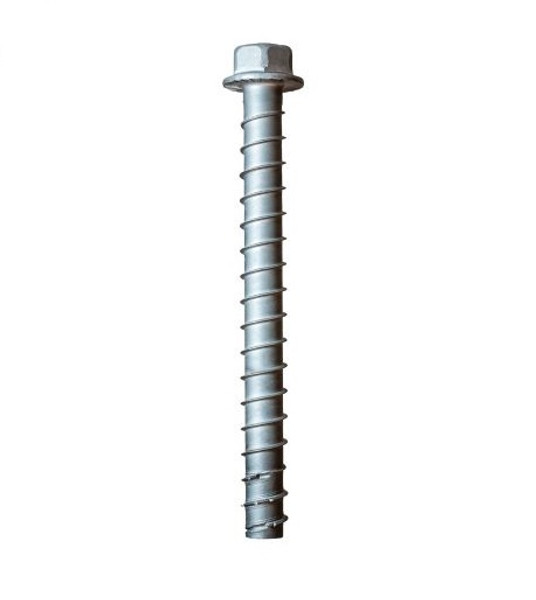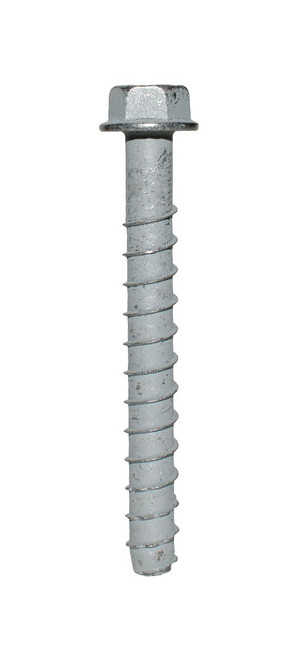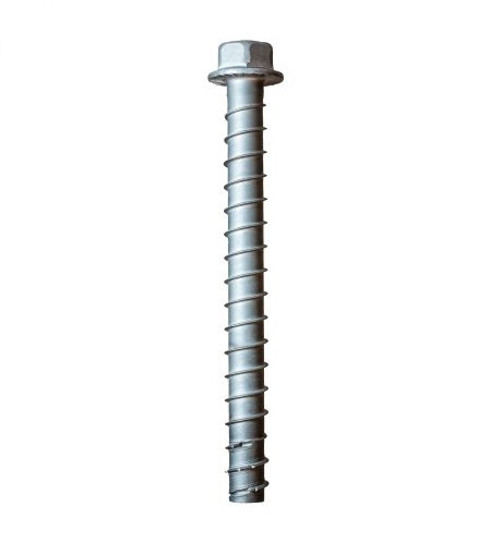Product Overview
THDC25200H6SS Titen Screw Anchor
Titen HD screw anchors are a trusted anchor solution because they offer the performance that specifiers need and the ease of installation that contractors demand. The Titen HD stainless-steel screw anchor for concrete and masonry sets the new standard for when the job calls for installation in multiple types of environments. It is the ultimate choice to provide fast and efficient installation, combined with long-lasting corrosion resistance for an unsurpassed peace-of-mind.
Innovative Design The serrated carbon-steel threads on the tip of the stainless-steel Titen HD are vital because they undercut the concrete as the anchor is driven into the hole, making way for the rest of the threads to interlock with the concrete. In order for these threads to be durable enough to cut into the concrete, they are formed from carbon steel that is then hardened and brazed onto the tip of the anchor.
Corrosion Resistant For dry, interior applications, carbon-steel corrosion is not a risk, but in any kind of exterior, coastal or chemical environment the anchor would be susceptible to corrosion. With the introduction of the THDSS, there is a state-of-the-art anchor solution that combines the corrosion resistance of Type 300 Series stainless steel with the undercutting ability of heat-treated carbon-steel cutting threads.
Type 300 Series stainless-steel screw anchors have different corrosion-resistant properties for different environments. When matched to the appropriate environment and application, anchors made from Type 300 Series stainless steel will resist the effects of corrosion and maintain their strength and integrity. Type 316 is the optimal choice for applications in corrosive or extreme environments such as salt water, or when chemical or corrosive solutions are present. Type 304 is a cost-effective solution for less extreme applications where the environment may be wet, moist or damp.
Key Features:
THDSS stainless-steel screw anchor available in 1/4", 5/8" and 3/4" diameters, in addition to the 3/8" and 1/2" sizes
Ideal for exterior or corrosive environments
Less carbon steel, less expansion
Installs with an impact wrench or by hand tool
Code listed in IAPMO UES ER-493 (concrete) and ICC-ES ESR-1056 (masonry)
Tested per ACI355.2 and AC193
U.S. Patents: 8,747,042 and 9,517,519
Material:
Type 316 and Type 304 stainless steel with carbon-steel lead threads
Installation:
Drill a hole in the base material using a carbide drill bit (complying with ANSI B212.15) with the same diameter as the nominal diameter of the anchor to be installed. Drill the hole to the specified minimum hole depth overdrill (see table below) to allow the thread tapping dust to settle, and blow it clean using compressed air. (Overhead installations need not be blown clean.) Alternatively, drill the hole deep enough to accommodate embedment depth and the dust from drilling and tapping.
Insert the anchor through the fixture and into the hole.
Tighten the anchor into the base material until the hex-washer head contacts the fixture.
Caution:
Holes in steel fixtures to be mounted should match the diameter specified in the table below if steel is thicker than 12 gauge.
Use a Titen HD screw anchor one time only installing the anchor multiple times may result in excessive thread wear and reduce load capacity.
Do not use impact wrenches to install into hollow CMU.
Oversized holes in base material will reduce or eliminate the mechanical interlock of the threads with the base material and reduce the anchors load capacity.
Titen HD screw anchors are a trusted anchor solution because they offer the performance that specifiers need and the ease of installation that contractors demand. The Titen HD stainless-steel screw anchor for concrete and masonry sets the new standard for when the job calls for installation in multiple types of environments. It is the ultimate choice to provide fast and efficient installation, combined with long-lasting corrosion resistance for an unsurpassed peace-of-mind.
Innovative Design The serrated carbon-steel threads on the tip of the stainless-steel Titen HD are vital because they undercut the concrete as the anchor is driven into the hole, making way for the rest of the threads to interlock with the concrete. In order for these threads to be durable enough to cut into the concrete, they are formed from carbon steel that is then hardened and brazed onto the tip of the anchor.
Corrosion Resistant For dry, interior applications, carbon-steel corrosion is not a risk, but in any kind of exterior, coastal or chemical environment the anchor would be susceptible to corrosion. With the introduction of the THDSS, there is a state-of-the-art anchor solution that combines the corrosion resistance of Type 300 Series stainless steel with the undercutting ability of heat-treated carbon-steel cutting threads.
Type 300 Series stainless-steel screw anchors have different corrosion-resistant properties for different environments. When matched to the appropriate environment and application, anchors made from Type 300 Series stainless steel will resist the effects of corrosion and maintain their strength and integrity. Type 316 is the optimal choice for applications in corrosive or extreme environments such as salt water, or when chemical or corrosive solutions are present. Type 304 is a cost-effective solution for less extreme applications where the environment may be wet, moist or damp.
Key Features:
THDSS stainless-steel screw anchor available in 1/4", 5/8" and 3/4" diameters, in addition to the 3/8" and 1/2" sizes
Ideal for exterior or corrosive environments
Less carbon steel, less expansion
Installs with an impact wrench or by hand tool
Code listed in IAPMO UES ER-493 (concrete) and ICC-ES ESR-1056 (masonry)
Tested per ACI355.2 and AC193
U.S. Patents: 8,747,042 and 9,517,519
Material:
Type 316 and Type 304 stainless steel with carbon-steel lead threads
Installation:
Drill a hole in the base material using a carbide drill bit (complying with ANSI B212.15) with the same diameter as the nominal diameter of the anchor to be installed. Drill the hole to the specified minimum hole depth overdrill (see table below) to allow the thread tapping dust to settle, and blow it clean using compressed air. (Overhead installations need not be blown clean.) Alternatively, drill the hole deep enough to accommodate embedment depth and the dust from drilling and tapping.
Insert the anchor through the fixture and into the hole.
Tighten the anchor into the base material until the hex-washer head contacts the fixture.
Caution:
Holes in steel fixtures to be mounted should match the diameter specified in the table below if steel is thicker than 12 gauge.
Use a Titen HD screw anchor one time only installing the anchor multiple times may result in excessive thread wear and reduce load capacity.
Do not use impact wrenches to install into hollow CMU.
Oversized holes in base material will reduce or eliminate the mechanical interlock of the threads with the base material and reduce the anchors load capacity.









